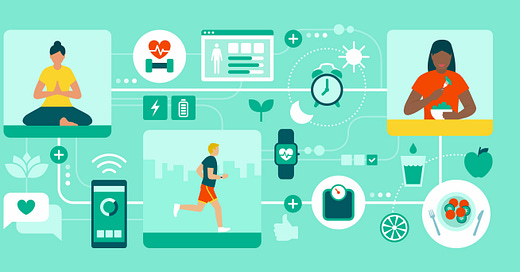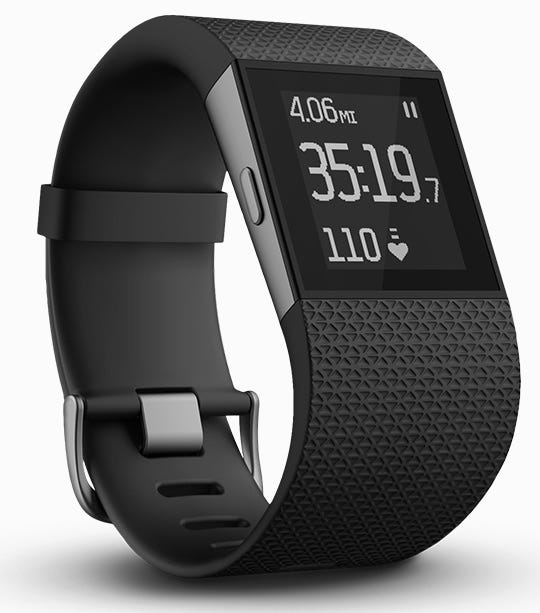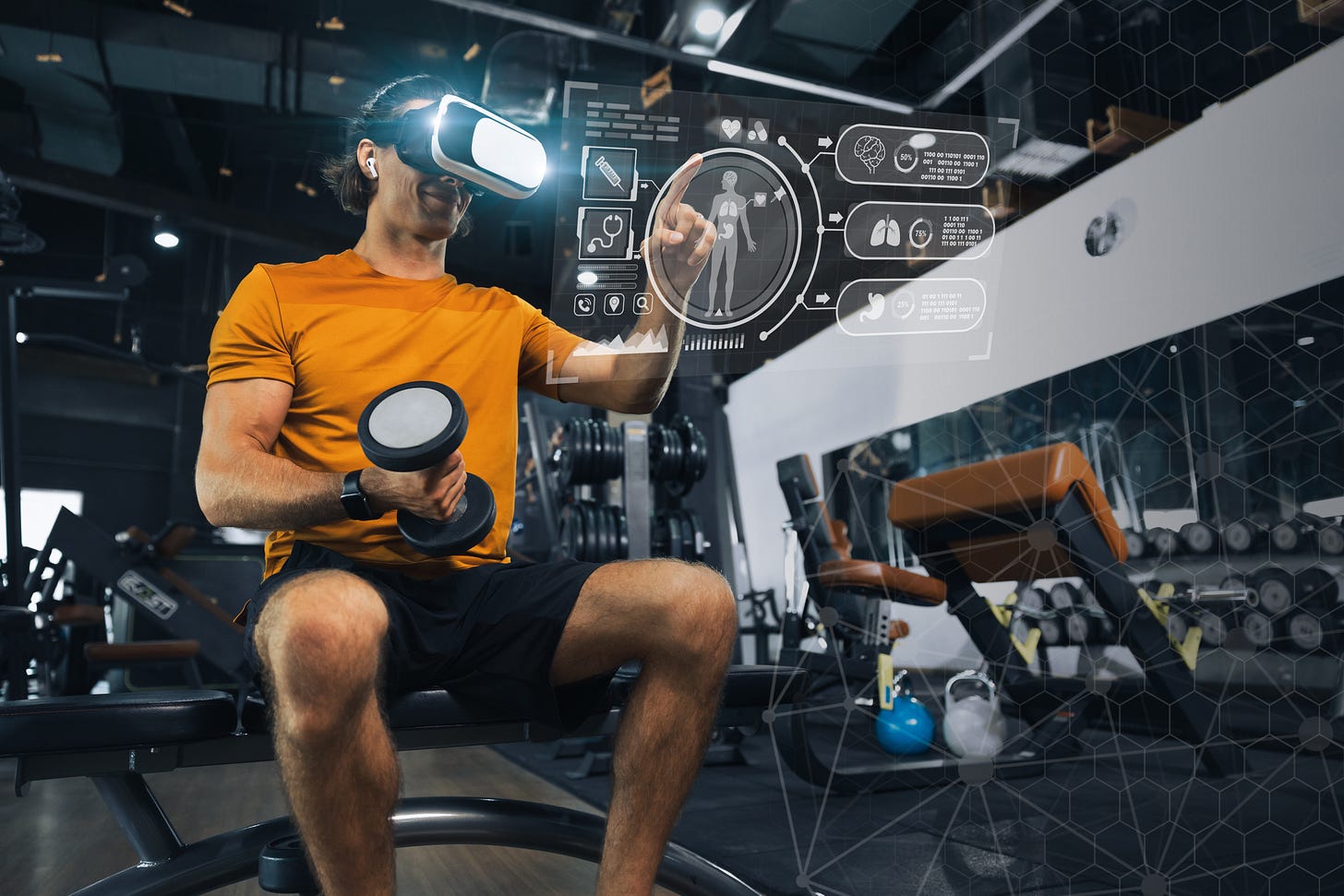Issue 004: Connected Fitness and its Implications on the Future of Consumer Technologies
💪🌍 Tech Pumping Up Both Your Workout And Your Future Devices
Bi-weekly writing about cultural shifts and next-generation start-ups building for the ‘consumer of tomorrow’. If you haven’t subscribed, join other like-minded future-forward thinkers by subscribing here:
TL;DR
Connected fitness involves the use of technology like wearables, apps, and smart equipment to provide personalized and convenient workout experiences. It offers benefits like motivation through social features and progress tracking.
The global connected fitness market is growing rapidly, expected to reach over $19 billion by 2032. Key drivers are increasing health awareness, wearable adoption, and technological advances making devices more accessible.
Major trends shaping the future of connected fitness include greater personalization through AI and data analytics, integration with other health apps for a holistic view of wellness, emphasis on social engagement, and more affordable options.
Connected fitness solutions are impacting other consumer technologies like wearables, VR/AR, smart homes, social media, and insurance by promoting healthy habits and behaviors. Useful applications like payments, tracking, socialization, gamification, and personalization are being adapted from fitness to other sectors.
💪 What is Connected Fitness?
Connected fitness is the use of digital technology to enhance the fitness experience. It can involve a variety of devices and apps, such as:
Smart fitness trackers that track your heart rate, steps, and other metrics.
Workout apps that provide access to a library of on-demand or live classes.
Smart exercise equipment that connects to the internet and can be controlled by a mobile device.
Connected fitness can offer a number of benefits, including:
Convenience: You can work out at home, without having to go to the gym.
Personalization: Connected fitness apps can tailor workouts to your individual needs and goals.
Motivation: You can connect with other users and compete for challenges or rewards.
Tracking: Connected fitness devices can track your progress over time, so you can see how you're doing.
The connected fitness market is growing rapidly and is expected to continue to grow in the years to come. This is due to a number of factors, including the increasing popularity of wearable devices, the demand for convenient and personalized fitness experiences, and the growing awareness of the importance of health and wellness.
Here are some of the most popular connected fitness devices and apps:
Mirror: Mirror is a smart home mirror that can be used for a variety of fitness activities, including yoga, Pilates, and strength training. Mirror offers a library of on-demand and live classes, as well as the ability to stream your own workouts.
Tonal: Tonal is a smart home gym that uses AI to provide personalized workouts. Tonal can be used for a variety of exercises, including strength training, cardio, and yoga.
Fitbit: Fitbit is a leading provider of wearable fitness trackers. Fitbit trackers track your steps, heart rate, sleep, and other metrics. Fitbit also offers a variety of fitness apps and challenges.
Strava: Strava is a social fitness app that allows you to track your workouts and connect with other users. Strava also offers a variety of challenges and features to help you stay motivated.
📈 The Connected Fitness Market: Headwinds & Tailwinds
The global home fitness equipment market size is expected to reach $19 billion, exhibiting an impressive CAGR of 5% between 2022 and 2032, from its current valuation of $12 billion in 2022.
The growth of the connected fitness market is being driven by a number of factors, including:
The growing demand for fitness: More and more people are looking for ways to improve their health and fitness, and connected fitness devices and services offer a convenient and effective way to do this.
The increasing adoption of wearable devices: Wearable devices, such as smartwatches and fitness trackers, are becoming increasingly popular, and they are providing people with data about their fitness that can be used to improve their workouts.
Advances in technology: Technological advances are making connected fitness devices more affordable, accessible, and user-friendly.
The rise of social media: Social media is being used to connect people with each other and with fitness experts, which can help to motivate and support people in their fitness journey.
The connected fitness market is segmented by product, application, and region. By product, the market is segmented into wearable devices, smart home fitness equipment, and connected fitness software. By application, the market is segmented into fitness tracking, virtual fitness classes, and live fitness classes.
Some of the headwinds for the connected fitness market include:
Cost: Connected fitness devices and subscriptions can be expensive, which can be a barrier to entry for some people.
Data privacy: There are concerns about data privacy and security with connected fitness devices.
Technological challenges: There are technological challenges to overcome, such as ensuring that devices are compatible with each other and that data is secure.
Acceptance: There is still some resistance to connected fitness devices, as some people prefer traditional methods of fitness.
Overall, the connected fitness market is facing some challenges, but there are also a number of tailwinds that are driving growth. The market is expected to continue to grow in the coming years, as more people adopt connected fitness devices and services.
🔮 Predictions for the Connected Fitness Market Opportunity
Here are some predictions for connected fitness companies in the coming years:
There will be a greater focus on personalization. Connected fitness companies will increasingly focus on providing personalized workouts and experiences for their users. This will be done through the use of data and AI to track users' progress and preferences and to recommend exercises that are tailored to their individual needs.
There will be more integration with other health and wellness apps. Connected fitness companies will increasingly integrate with other health and wellness apps, such as those that track sleep, nutrition, and stress levels. This will allow users to get a more holistic view of their health and fitness, and to make better decisions about their overall well-being.
There will be a greater emphasis on social engagement. Connected fitness companies will increasingly emphasize social engagement, as this is a critical factor in keeping users motivated and engaged. This will be done through features such as live classes, challenges, and social media integration.
There will be more affordable options available. As the connected fitness market matures, there will be more affordable options available to consumers. This will make connected fitness more accessible to a broader range of people.
Overall, the future of connected fitness looks bright. The market is growing rapidly, and there are a number of trends that are likely to drive further growth in the coming years. Connected fitness companies that are able to adapt to these trends and provide personalized, engaging, and affordable experiences are well-positioned to succeed in the years to come.
🌟 What are the implications Connected Fitness has on other consumer technologies?
Connected fitness solutions have a number of implications for other consumer technologies. Here are a few examples:
Wearable devices: Connected fitness solutions are driving the growth of wearable devices, such as smartwatches and fitness trackers. These devices track users' fitness data, such as steps, heart rate, and sleep, and can be used to control connected fitness equipment.
Virtual reality (VR) and augmented reality (AR): VR and AR are being used to create more immersive and engaging fitness experiences. For example, VR can be used to create virtual gyms or studios, while AR can be used to overlay workout instructions in the real world.
Smart home devices: Connected fitness solutions are also being integrated with smart home devices, such as thermostats and lights. This allows users to control their home environment to optimize their workouts. For example, users can set their thermostat to a cooler temperature before a workout or turn on the lights in their workout space.
Social media: Connected fitness solutions are also being used to connect users with each other and with fitness experts. This can help users stay motivated and accountable, and it can also provide them with access to new workout ideas and techniques.
Health insurance: Connected fitness solutions are also being used by health insurance companies to incentivize healthy behavior. For example, some insurance companies offer discounts to members who use connected fitness devices or who meet specific fitness goals.
Some use cases seen in connected fitness technologies that can be adapted to other consumer technologies include:
Payments: Connected fitness devices can be used to make payments for goods and services. For example, a user could use their wearable device to pay for a smoothie at a cafe or to purchase a new pair of shoes online. This could be done by linking the device to a payment account, such as a credit card or PayPal.
Tracking: Connected fitness devices can be used to track a variety of data, such as steps taken, calories burned, and heart rate. This data can be used to improve fitness and health, but it can also be used for other purposes, such as tracking sleep patterns or monitoring stress levels. This data could be used by other consumer technologies to provide personalized recommendations or to offer targeted advertising.
Socialization: Connected fitness devices can be used to connect with other users and participate in challenges. This can help to motivate and support people in their fitness journey. This social aspect could be adapted to other consumer technologies, such as gaming or dating apps.
Gamification: Connected fitness devices can be used to gamify fitness, making it more fun and engaging. This can be done by awarding points or badges for completing workouts or by competing with friends in challenges. This gamification could be adapted to other consumer technologies, such as education or productivity apps.
Personalization: Connected fitness devices can be used to personalize workouts and recommendations. This can be done by tracking a user's fitness data and preferences. This personalization could be adapted to other consumer technologies, such as streaming services or shopping apps.
Overall, connected fitness solutions are having a significant impact on other consumer technologies. These are just a few examples of how connected fitness technologies can be adapted to other consumer technologies. As the connected fitness market continues to grow, we can expect to see even more innovation in this area.
🎁 Sooo let’s wrap it up…
Connected fitness is transforming the way people approach health and fitness by harnessing technology to provide engaging, personalized, and convenient workout experiences. As consumer interest in wellness continues to grow, the global connected fitness market is rapidly expanding and is expected to exceed $19 billion by 2032.
Key drivers fueling this growth include the rising popularity of wearables, increasing adoption of smart home gym equipment, and innovations in augmented/virtual reality and artificial intelligence that allow for highly customized workouts. While some challenges like cost and data privacy remain, connected fitness presents enormous opportunities for businesses to tap into consumers' demand for social, gamified, and tailored fitness experiences.
Ultimately, connected fitness solutions are not only changing fitness but also having ripple effects in other realms like payments, insurance, and social media as consumers seek to integrate technology into all aspects of a healthy lifestyle.











